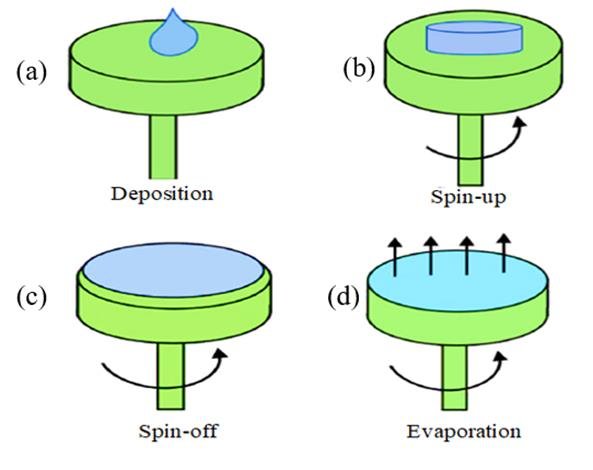Spin Coating: A Versatile Technique for Thin Film Deposition
What is Spin Coating?
Spin coating is a widely used technique for depositing thin, uniform films onto flat substrates. It involves the application of a liquid material onto a rotating substrate, which spreads the material evenly across the surface through centrifugal force. As the substrate spins, the liquid film thins and dries, leaving behind a thin, solid film. Spin coating is extensively employed in various fields, including microelectronics, optics, and nanotechnology, for the fabrication of thin films with precise thickness and uniformity.

Spin Coating Process
The spin coating process can be divided into four main stages:
- Deposition: The liquid material, typically a polymer solution or a nanoparticle dispersion, is dispensed onto the center of the substrate. The substrate is held in place by a vacuum chuck to prevent slippage during rotation.
- Acceleration: The substrate is accelerated to a high rotational speed, typically ranging from 1,000 to 10,000 rpm. The acceleration causes the liquid to spread outward from the center, driven by centrifugal force.
- Thinning: As the substrate rotates at a constant speed, the liquid film thins due to the balance between centrifugal force and viscous force. Excess liquid is ejected from the edge of the substrate, leaving behind a thin, uniform film.
- Drying: The thin film undergoes solvent evaporation, which further reduces its thickness and solidifies the material. The drying process can be enhanced by applying heat or using a vacuum environment.
Factors Affecting Spin Coating
Several factors influence the quality and thickness of the spin-coated film:
- Rotational Speed: The thickness of the film is inversely proportional to the square root of the rotational speed. Higher speeds result in thinner films, while lower speeds produce thicker films.
- Solution Viscosity: The viscosity of the liquid material affects the spreading and thinning behavior during spin coating. Higher viscosity solutions result in thicker films, while lower viscosity solutions yield thinner films.
- Solution Concentration: The concentration of the solute (e.g., polymer or nanoparticles) in the liquid solution impacts the final film thickness. Higher concentrations lead to thicker films, while lower concentrations result in thinner films.
- Substrate Surface: The wettability and roughness of the substrate surface influence the adhesion and uniformity of the spin-coated film. Surface treatments, such as plasma cleaning or chemical modification, can improve the film quality.
- Environment: The temperature, humidity, and airflow in the spin coating environment can affect the drying rate and the final film properties. Controlled environmental conditions are essential for reproducible and high-quality films.
Applications of Spin Coating
Spin coating finds applications in various fields, leveraging its ability to produce thin, uniform films:
Microelectronics
Spin coating is extensively used in the fabrication of microelectronic devices, such as integrated circuits and solar cells. It is employed for depositing photoresists, dielectric layers (e.g., silicon dioxide, silicon nitride), and conductive polymers (e.g., PEDOT:PSS) onto silicon wafers or other substrates. The precise thickness control and uniformity achieved by spin coating are crucial for the reliable performance of electronic devices.
Optics and Photonics
Spin coating is utilized in the production of optical coatings, such as antireflective coatings, interference filters, and waveguides. By controlling the thickness and refractive index of the spin-coated films, desired optical properties can be achieved. For example, spin coating is used to deposit thin films of materials like titanium dioxide (TiO2) and silicon dioxide (SiO2) to create antireflective coatings for lenses and solar cells. Spin coating enables the fabrication of high-quality optical devices with precise thickness and uniformity.
Nanotechnology
Spin coating is a valuable technique for depositing nanostructured materials, such as nanoparticle films, polymer nanocomposites, and self-assembled monolayers. It allows for the creation of thin films with controlled thickness and composition, enabling the study and application of nanoscale phenomena. By adjusting the spin coating parameters and the properties of the nanoparticle dispersion (e.g., particle size, surface chemistry), the arrangement and packing density of the nanoparticles in the film can be tuned. This control over nanoparticle organization is crucial for applications such as nanostructured coatings, sensors, and optoelectronic devices.
Advanced Spin Coating Techniques
While conventional spin coating is widely used, advanced variations of the technique have been developed to address specific requirements. For example, dip-pen nanolithography combines spin coating with atomic force microscopy (AFM) to deposit nanoscale patterns of functional materials. Another variation, known as spray coating, involves the deposition of liquid droplets onto a rotating substrate, enabling the coating of non-flat surfaces. These advanced techniques expand the capabilities of spin coating for specialized applications.
Advantages and Limitations
Spin coating offers several advantages, including its simplicity, reproducibility, and ability to produce thin, uniform films. It is a rapid and cost-effective method for depositing films over large areas, making it suitable for high-throughput manufacturing. However, spin coating also has limitations. It is primarily applicable to flat substrates and may result in material waste due to the ejection of excess liquid during the spinning process. Additionally, the final film properties can be sensitive to environmental conditions and require careful control of processing parameters.
Further Reading
Cogent Engineering, A critical overview of thin films coating technologies for energy applications
Indian Journal of Physics, Fundamental understanding and modeling of spin coating process: A review
Journal of Materials Chemistry B, Spin-coated freestanding films for biomedical applications
